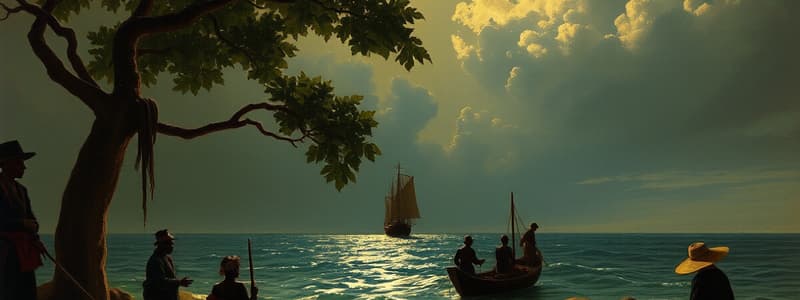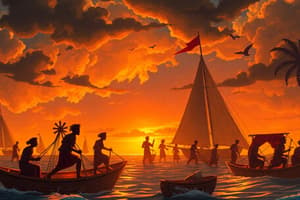Podcast
Questions and Answers
What was transported from Europe to Africa in the triangular trade?
What was transported from Europe to Africa in the triangular trade?
- Agricultural produce
- Enslaved Africans
- Raw materials
- Manufactured goods (correct)
What was a significant consequence of the triangular trade on African societies?
What was a significant consequence of the triangular trade on African societies?
- Population decline due to enslavement (correct)
- Expansion of urban centers
- Cultural enrichment from European ideas
- Increased agricultural production
During which phase of the triangular trade were enslaved Africans transported across the Atlantic?
During which phase of the triangular trade were enslaved Africans transported across the Atlantic?
- Americas to Europe
- Africa to Europe
- Europe to Africa
- Africa to Americas (Middle Passage) (correct)
What type of goods were carried from the Americas back to Europe?
What type of goods were carried from the Americas back to Europe?
What was one of the primary motivations for European involvement in the triangular trade?
What was one of the primary motivations for European involvement in the triangular trade?
What did abolition movements primarily advocate for?
What did abolition movements primarily advocate for?
Which event marked a significant legislative step towards ending the slave trade in Britain?
Which event marked a significant legislative step towards ending the slave trade in Britain?
What type of impact did the triangular trade have on cultural aspects in the Americas?
What type of impact did the triangular trade have on cultural aspects in the Americas?
Flashcards are hidden until you start studying
Study Notes
Triangular Trade: Slave Trade
-
Definition: The triangular trade refers to the transatlantic slave trade system that connected Europe, Africa, and the Americas from the 16th to the 19th centuries.
-
Three Main Legs of the Trade:
-
Europe to Africa:
- European ships carried manufactured goods (e.g., textiles, guns, alcohol) to Africa.
- These goods were exchanged for enslaved Africans.
-
Africa to the Americas (Middle Passage):
- Enslaved Africans were transported across the Atlantic Ocean to the Americas.
- Conditions were brutal; high mortality rates due to overcrowding, disease, and malnutrition.
-
Americas to Europe:
- Ships carried raw materials (e.g., sugar, cotton, tobacco) back to Europe.
- These goods were produced by enslaved labor on plantations.
-
-
Impact on Africa:
- Population decline due to enslavement and warfare fueled by demand for slaves.
- Societal disruption and destabilization of communities.
- Increased wealth for some African leaders who participated in the trade.
-
Impact on the Americas:
- Labor supply for plantations and agricultural systems.
- Economic growth in colonies reliant on slave labor.
- Cultural contributions from African traditions, music, and practices.
-
Abolition Movements:
- Growing opposition to slavery in the late 18th century.
- Activists and movements emerged in both Europe and the Americas advocating for abolition.
- Legislation passed to end the slave trade (e.g., British Abolition of the Slave Trade Act in 1807).
-
Legacy:
- Long-lasting social, economic, and cultural impacts in both Africa and the Americas.
- Ongoing discussions about racial inequality and reparations.
- Historical awareness of the slave trade’s consequences on contemporary society.
Triangular Trade: Slave Trade
- Triangular trade was a transatlantic system connecting Europe, Africa, and the Americas from the 16th to the 19th centuries.
- Three Main Legs of the Trade:
- Europe to Africa:
- European ships transported manufactured goods like textiles, guns, and alcohol to Africa.
- These goods were traded for enslaved Africans, marking the beginning of the slave trade.
- Africa to the Americas (Middle Passage):
- Enslaved Africans were forcibly transported to the Americas across the Atlantic.
- The Middle Passage was characterized by brutal conditions, leading to high mortality rates from overcrowding, disease, and malnutrition.
- Americas to Europe:
- Ships returned to Europe carrying raw materials, including sugar, cotton, and tobacco, cultivated by enslaved labor on plantations.
- Europe to Africa:
Impact on Africa
- Significant population decline resulted from enslavement, warfare, and the loss of community leaders.
- Societal structures were disrupted, leading to destabilization of local communities.
- Some African leaders gained wealth and power by participating in the slave trade.
Impact on the Americas
- Provided a labor supply essential for the success of plantations and agricultural enterprises.
- Contributed to economic growth in colonies heavily dependent on slave labor.
- Enslaved Africans brought cultural elements, influencing music and traditions in the Americas.
Abolition Movements
- Opposition to slavery rose in the late 18th century, highlighting moral and human rights issues.
- Activists and movements advocating for abolition emerged in Europe and the Americas.
- Significant legislation, including the British Abolition of the Slave Trade Act in 1807, was enacted to end the slave trade.
Legacy
- The slave trade left enduring social, economic, and cultural impacts in both Africa and the Americas.
- Discussions around racial inequality and reparations continue to be relevant in contemporary society.
- Historical awareness of the consequences of the slave trade informs current discussions about racism and injustice.
Studying That Suits You
Use AI to generate personalized quizzes and flashcards to suit your learning preferences.



